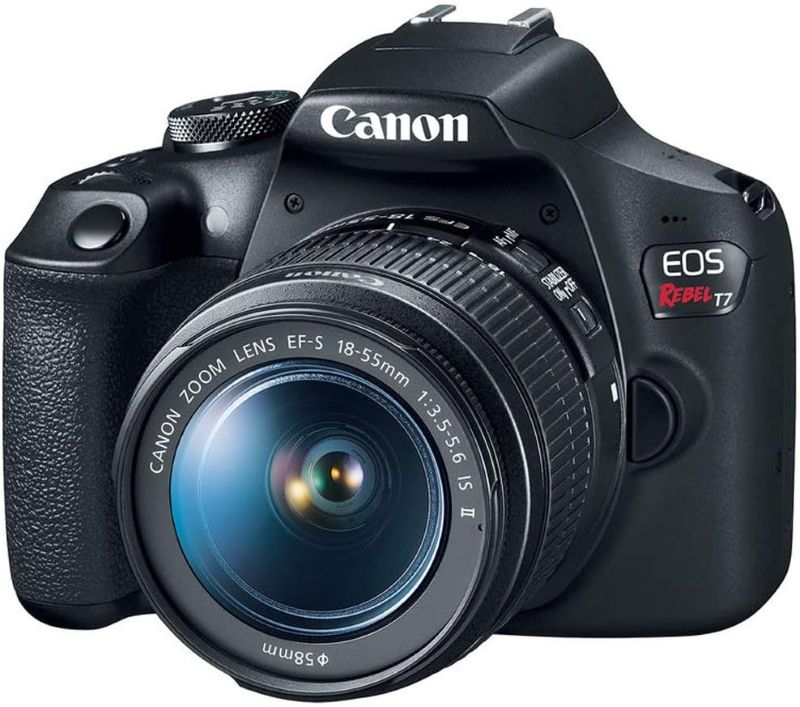Getting started in photography can feel overwhelming. With so many cameras and lenses out there, choosing the right gear is tough. The Canon Rebel T7 combined with the 18-55mm kit lens is a popular choice for beginners. It offers a great mix of ease of use, decent quality, and affordability. If you want to take better photos right away, knowing how your camera and lens work is key. This guide will walk you through the important features, tips, and tricks to help you shoot confidently from day one.

Understanding the Canon Rebel T7 Camera
Overview of the Rebel T7
The Canon Rebel T7 is a entry-level DSLR designed for beginners. It features a 24.1-megapixel APS-C sensor, which produces sharp, clear images. Its ISO range from 100 to 6400 lets you shoot in different lighting conditions without much noise. The T7 also offers Full HD 1080p video recording, making it versatile for photo and video projects. The camera is lightweight, compact, and easy to hold, ideal for new photographers.
Key Features & Settings
This model has simple Scene Modes that quickly optimize settings for landscapes, portraits, or action shots. The Autofocus system is fast enough for most situations, making it easier to keep subjects sharp. Built-in Wi-Fi allows quick sharing or remote control with a smartphone. Mastering the basics—aperture, shutter speed, ISO—is essential for better photos. These controls often intimidate beginners, but learning them unlocks your creative potential.
Advantages of the Rebel T7 for Beginners
The Rebel T7 costs less than many advanced models, but still delivers impressive image quality. It also grows with your skills; you can upgrade lenses anytime. Plus, it’s compatible with a wide range of Canon lenses, giving you future options. Its intuitive interface helps new users get comfortable with manual settings. All these features make the Rebel T7 an excellent choice for building your skills.
Exploring the 18-55mm Lens: Versatility and Limitations
Specifications and Optical Characteristics
The 18-55mm lens is a standard kit lens that covers a broad focal length, from wide-angle to short telephoto. It lets you capture everything from landscapes to portraits with one lens. The lens also has image stabilization, which helps reduce blurry photos. Its variable aperture of f/3.5-5.6 means it doesn’t perform as well in low light. Still, it’s perfect for everyday shots.
Popular Uses & Real-World Applications
This lens shines in many scenarios. Want a family photo? The 18mm wide end is perfect. Shooting a close-up portrait? Turn to 55mm for a tighter crop. Planning a day of sightseeing? Its versatility handles most scenes without changing lenses. It’s great for amateurs who want to shoot anything from nature to street photography.
Limitations to Be Aware Of
Having a variable aperture means your lens lets in less light as you zoom in, making low-light photos more challenging. The kit lens also lacks the sharpness and creative control of prime lenses. If you find yourself taking more advanced shots, you might need a prime lens or a zoom with a larger maximum aperture. Upgrading is an option once you’re comfortable with basic photography.
Practical Tips for Beginners Using the Rebel T7 and 18-55mm Lens
Mastering Camera Settings
Start by using Auto mode to see how the camera works. Then, experiment with Scene Modes for quick adjustments. To take full control, switch to Manual mode. Adjust ISO for brightness, shutter speed for motion, and aperture for depth of field. For bright days, lower ISO; for indoor or night shots, increase it. Balancing these settings is key.
Composition and Framing
Good photos aren’t just about settings—they’re about composition. Use the Rule of Thirds to create balanced shots. Leading lines, framing, and interesting backgrounds add depth. Use your camera’s LCD screen to review shots quickly. Don’t be afraid to move around and find the best angle.
Shooting in Different Conditions
In daylight, keep ISO low and use smaller apertures for sharp images. For low-light or indoor scenes, increase ISO and open the aperture wider. Natural light often produces the best results—seek shadows and indirect sunlight for softer images. Using a tripod can help when shooting at night or in low light.
Maintenance and Care
Keep your lens clean using a microfiber cloth and lens cleaning solution. Avoid touching the glass. Store your camera in a dry, safe place away from dust and moisture. Regularly check and replace batteries so your camera is always ready to shoot.
Common Beginner Challenges and How to Overcome Them
Autofocus Issues
Sometimes the camera struggles to focus. Make sure your autofocus points are on the subject. Use focus lock for tricky shots. Practice tapping the shutter button halfway to focus before taking the picture.
Image Quality Concerns
Overexposed or underexposed photos happen easily when you don’t adjust settings. Use the exposure compensation feature or switch to Manual mode for more control. Review your photos on the LCD and adjust accordingly.
Creative Limitations
Relying on Auto can limit your creativity. Try switching to Manual mode when you feel comfortable. Experiment with different angles, lighting, and framing. Consider adding a prime lens later for sharper portraits or better low-light performance.
Expert Insights and Recommendations
Professional photographers often recommend starting simple, focusing on mastering your camera before investing in many accessories. They say, “Get comfortable with your gear, then explore upgrades.” For beginners, essentials include a tripod, extra batteries, and a polarizer filter. These tools help improve image quality and expand your creative options.
Conclusion
The Canon Rebel T7 and 18-55mm lens are perfect for new photographers. They teach you the basics while allowing room to grow. Learning how your camera works, practicing composition, and understanding your lens’s limits makes a big difference. The key is to keep shooting, trying new ideas, and having fun. Take your camera with you and start capturing moments today—your journey to better photos begins now.


